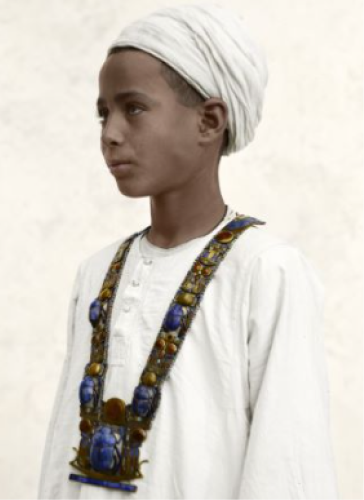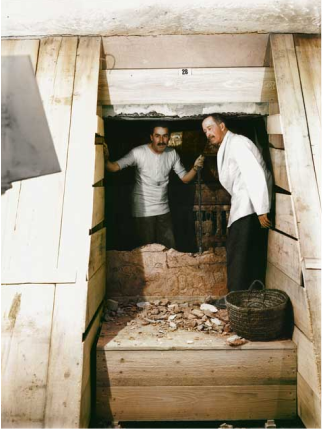July 1989
In 1989,
I was a university student backpacking through Egypt on my summer break. While
sightseeing on the west bank of the Nile across from Luxor, I met a Swedish
tourist at the Habu temple. The traveler told me that there was a restaurant
nearby owned by a man whose father had worked for Howard Carter. The next day I went to the
restaurant for breakfast with my friend John.
We met the owner and spoke
with him. He brought a book to our table and pointed out
photos of Howard Carter and Lord Carnarvon. He even showed us a photo of himself in
the book.
Burton photograph 1189 | © Griffith Institute, University of Oxford (colourised by Coposite Films)


Sheikh Hussein Abdel-Rassoul holds a framed photo of himself as a young boy wearing the ornate necklace from King Tut’s tomb. The photo of him as a boy was taken by photographer Harry Burton. © Francis T. Casey, Jr.
December 2020
In December 2020, I picked up and started browsing through my photo album of my trip to Egypt three decades earlier. I came across a photograph of an old man I met at a restaurant on the west bank of the Nile near Luxor. In my photograph the old man was holding a framed photo of himself as a twelve-year-old boy wearing a necklace, a necklace from King Tut’s tomb! I recalled what the old man had told me and went to my computer and did a Google image search for “12-year-old boy king Tut’s $6 million necklace.” To my surprise my computer screen filled with images like the one I had in my album, a photo of an old man holding a photo of a young boy wearing the necklace, or just the photo of the young boy holding the necklace. I clicked on one of the images and read the accompanying article where I read the following: “On November 4th, 1922, a 12-year-old house boy named Hussein Abdel-Rassoul, when fetching water, found the top of the staircase that led to King Tut’s tomb.
The man that I had met in 1989 was now being given credit as the individual who found King Tut’s tomb, the greatest royal burial tomb ever found!!!
King Tut's tomb
British archaeologist Howard Carter was credited with one of
the richest and most-celebrated contributions to Egyptology:
the discovery of King
Tutankhamen’s tomb on November 4,
1922. Carter excavated in the Valley of the Kings for eleven
years before he discovered Tut's tomb in 1922.
Burton p0509 (colourised by Dynamichrome) © Griffith Institute, University of Oxford.
King Tutankhamen
The discovery of King Tut’s tomb is considered one of the greatest archaeological discoveries. It was significant because it was the only royal burial tomb
found intact in modern times. The tomb contained over 5,000 artifacts which took about 10 years to photograph and catalog.

Burton p1545 (colourised by Dynamichrome)
© Griffith Institute, University of Oxford.
Lord Carnarvon
Lord Carnarvon was an English aristocrat best known as the financial backer of the search for and excavation of Tutankhamun's tomb in the Valley of the
Kings. In 1914 Lord Carnarvon received the concession to dig in the Valley of the Kings and hired Howard Carter to lead the work. Carter undertook a
systematic search of the Valley for any tombs missed by previous expeditions, in particular that of the Pharaoh Tutankhamun.
Burton p0291 (colourised by Dynamichrome) © Griffith Institute, University of Oxford.

Burton p0291 (colourised by Dynamichrome)
© Griffith Institute, University of Oxford.
Harry Burton
Prior to 1922 Harry Burton had earned a reputation as the finest archaeological photographer of his time. When Howard Carter discovered Tutankhamun’s
tomb in 1922, he promptly asked the Metropolitan Museum of Art in New York City for the loan of Burton’s services. Harry Burton became the official
photographer for the Tutankhamun excavation. He was the only person allowed to take photographs inside the tomb and photographed the contents of King
Tut’s tomb from 1922 to 1932.

Burton p0291 (colourised by Dynamichrome)
© Griffith Institute, University of Oxford.
Harry Burton
Prior to 1922 Harry Burton had earned a reputation as the finest archaeological photographer of his time. When Howard Carter discovered Tutankhamun’s
tomb in 1922, he promptly asked the Metropolitan Museum of Art in New York City for the loan of Burton’s services. Harry Burton became the official
photographer for the Tutankhamun excavation. He was the only person allowed to take photographs inside the tomb and photographed the contents of King
Tut’s tomb from 1922 to 1932.
Hussein Abdel-Rassoul
In 1922, Hussein Abdel-Rassoul was a 12-year-old house boy working for Howard Carter. Apparently, on November 4, 1922, when he was fetching water for the workers, he found the top step that led down the stairway to King Tut’s tomb. Half a century earlier two of Hussein ancestors, brothers Ahmed and Mohamed Abdel Rasoul, found the Deir el-Bahari cache of more than 50 mummies, including Ramesses the Great, when their goat fell down a crevasse.

Sheikh Hussein Abdel-Rassoul holds a framed photo of himself as a young boy wearing the ornate necklace from King Tut’s tomb. The photo of him as a boy was taken by photographer Harry Burton. © Francis T. Casey, Jr.
Not only did I meet the man who is now credited with finding King Tut’s tomb, the greatest royal burial tomb ever uncovered, but I recorded my conversation with him on a cassette recorder!!!
Proceed to the next page to listen to the recently uncovered rare audio recordings which are now available to the public for the first time!
Harry Burton’s photographs were used with permission from the Griffith Institute at Oxford University. For additional information please visit the Griffith Institute website pages: